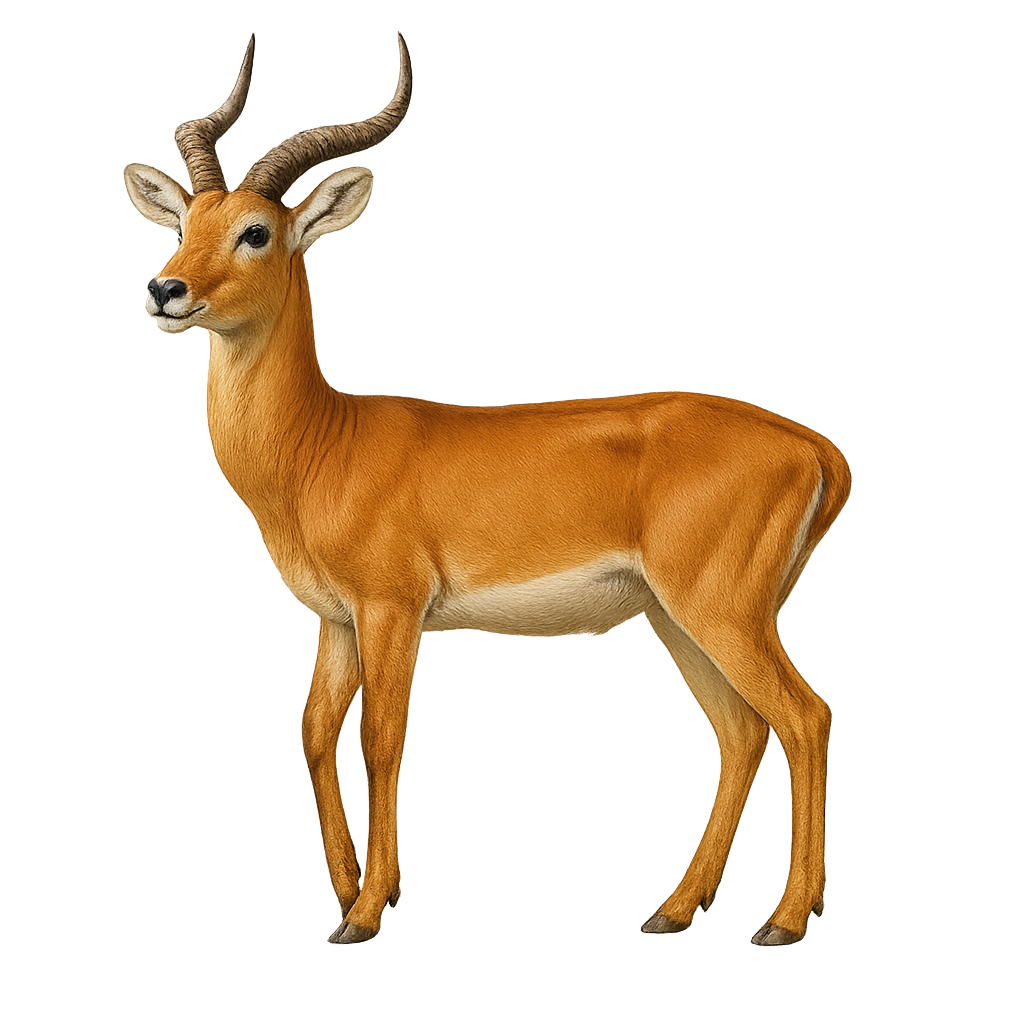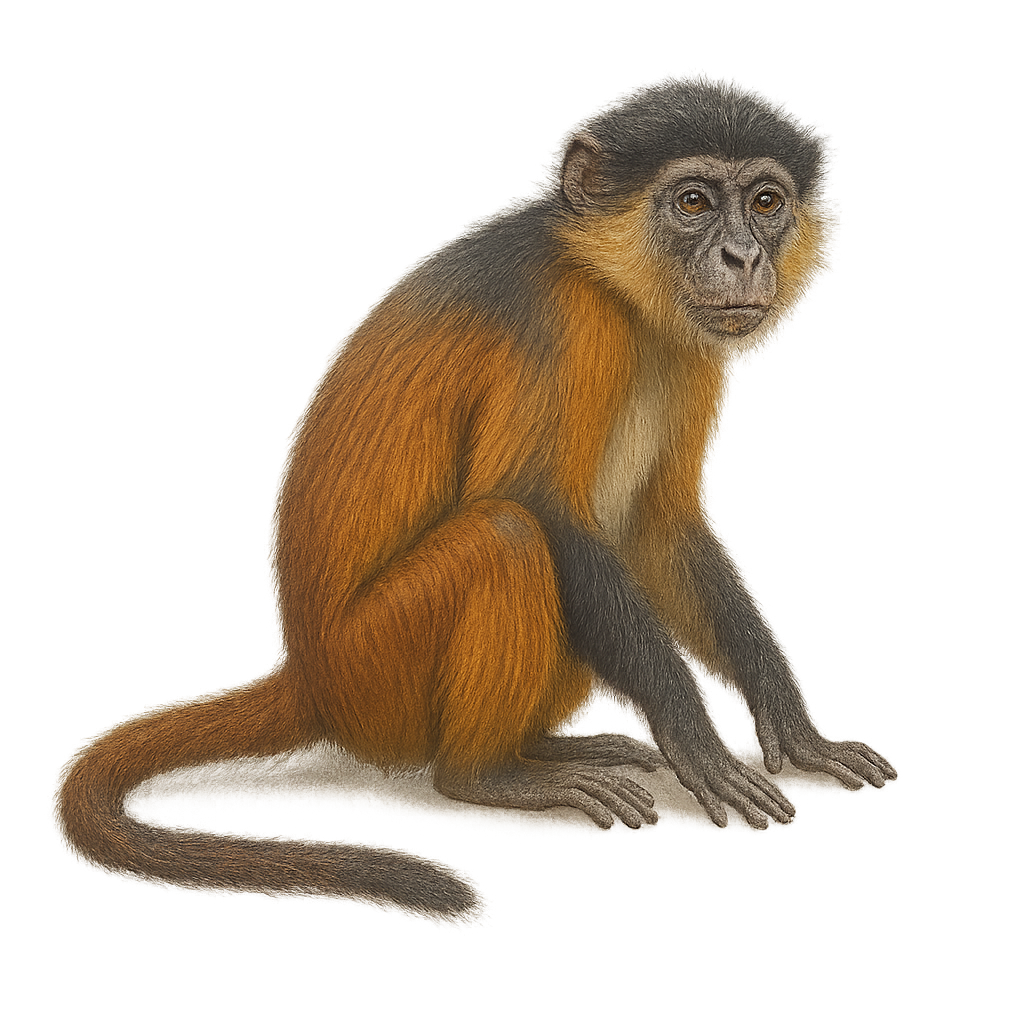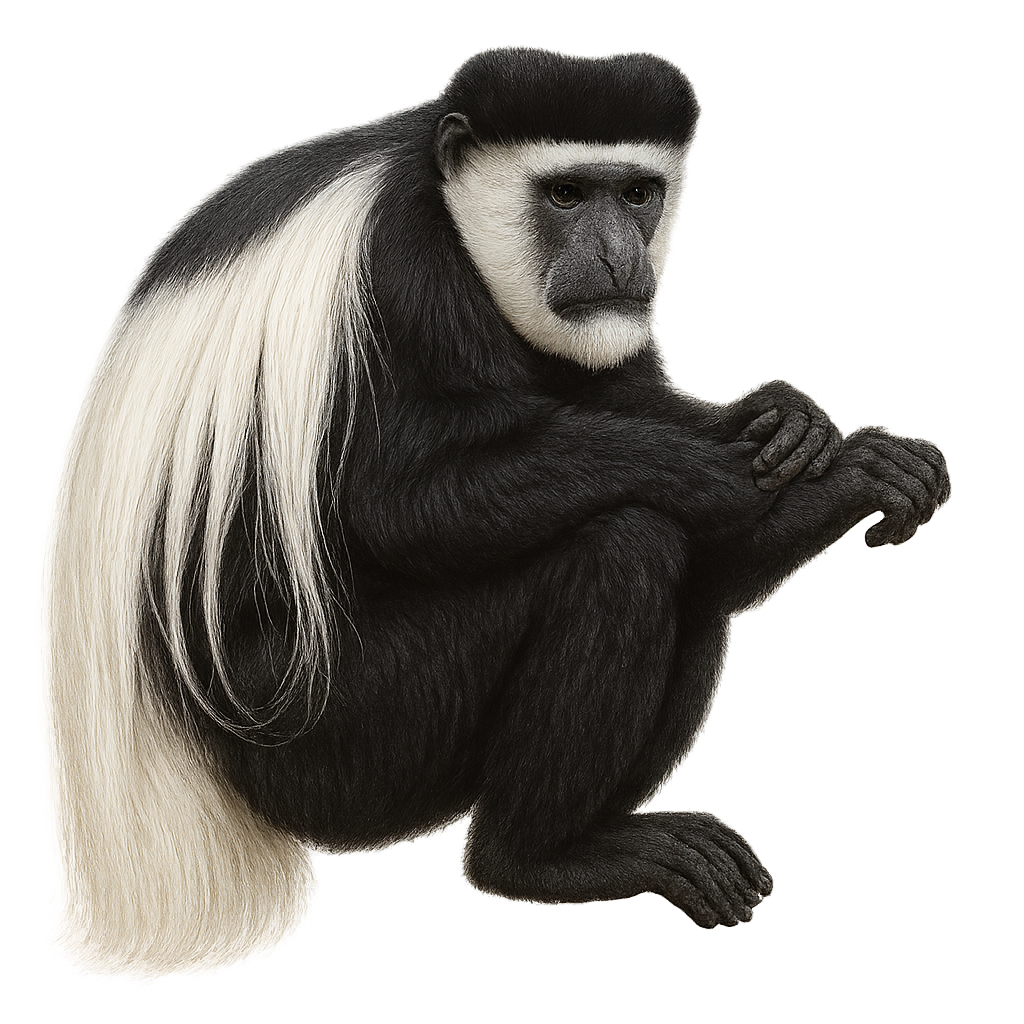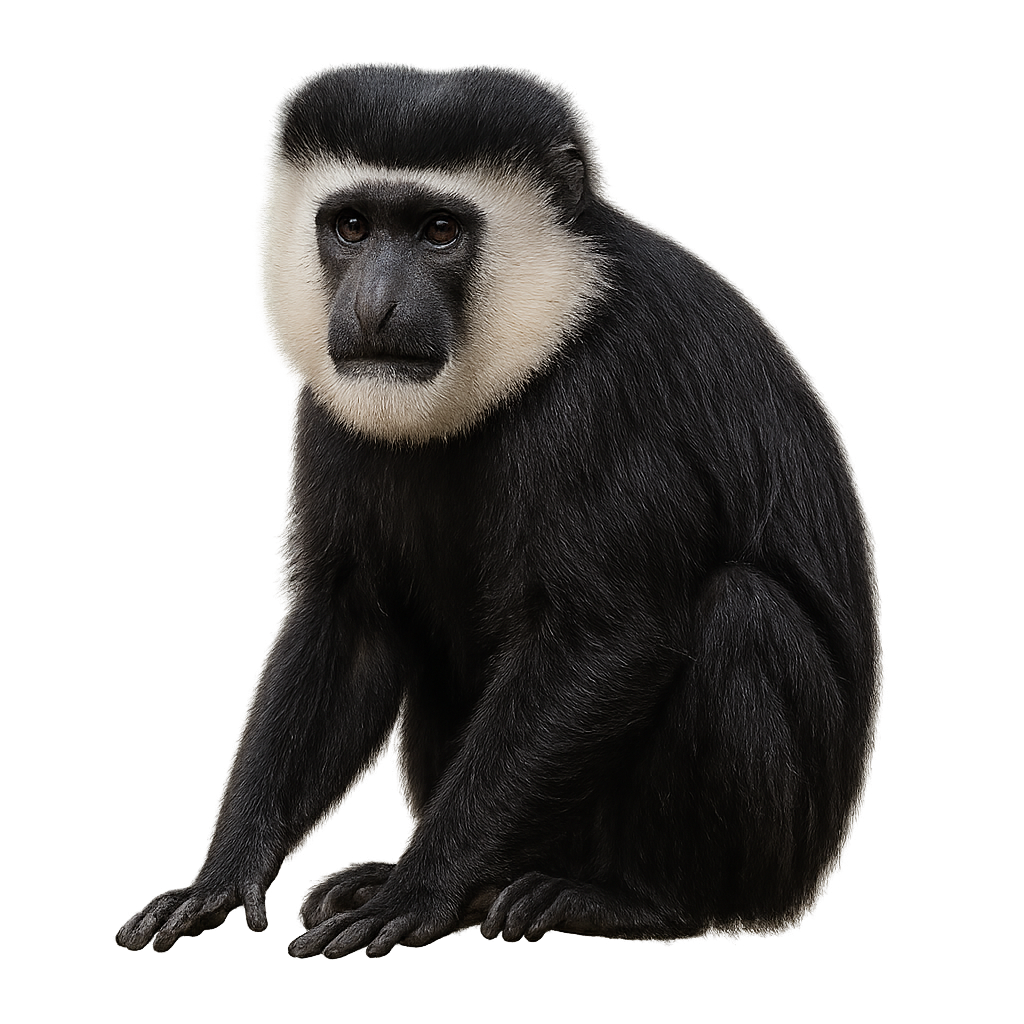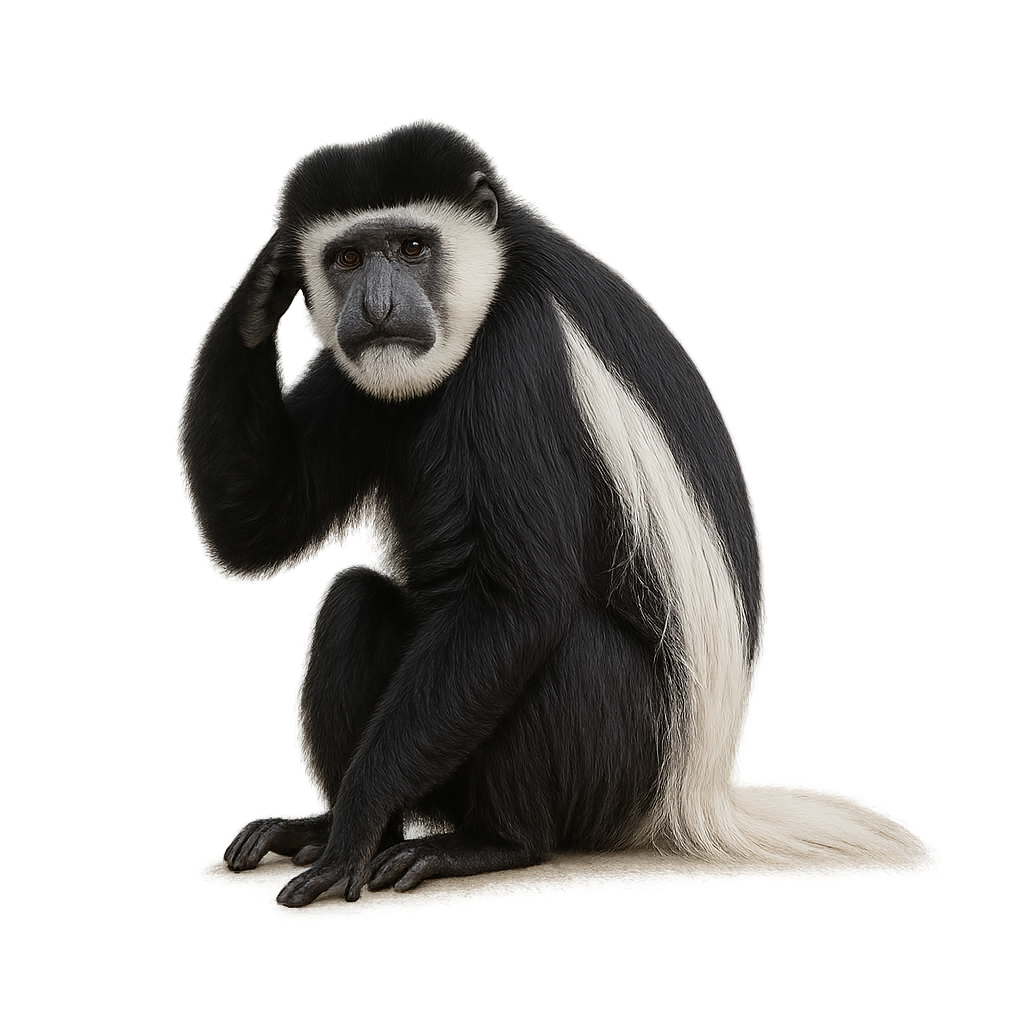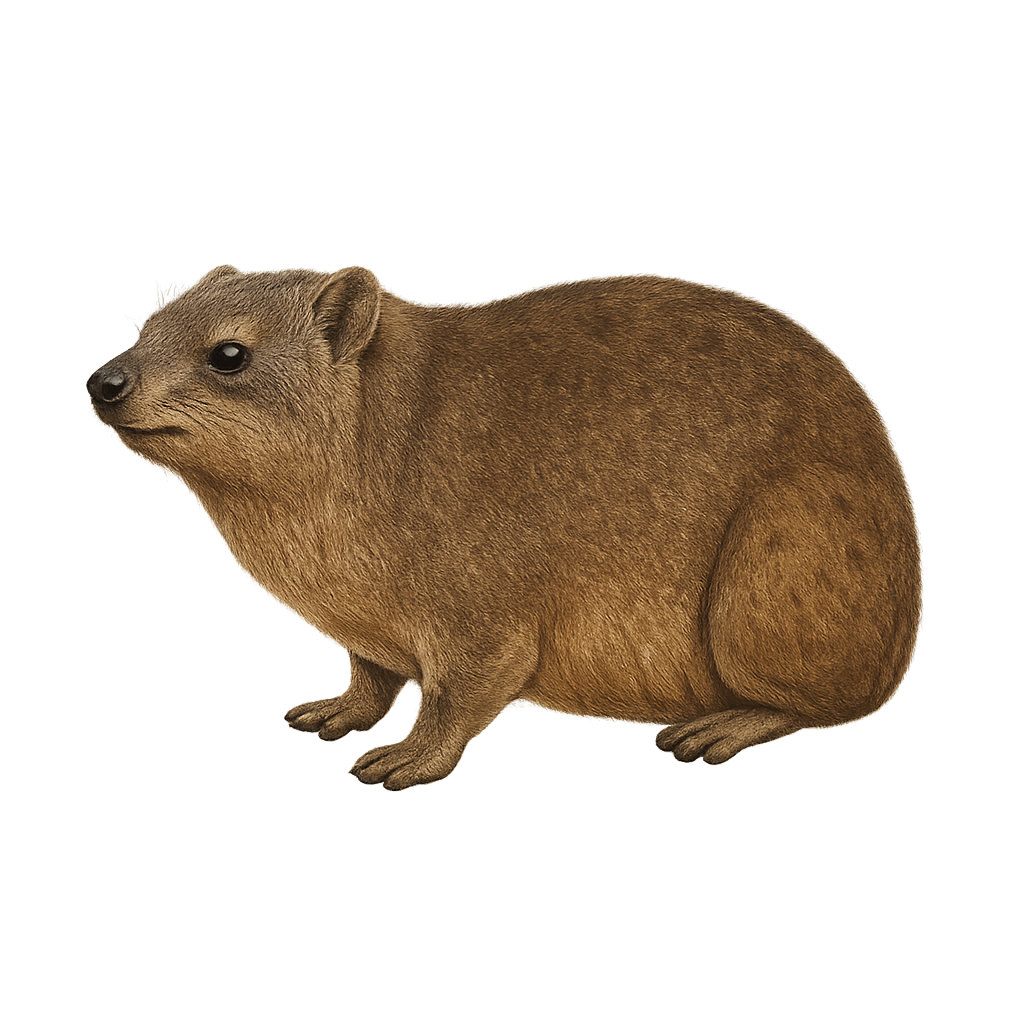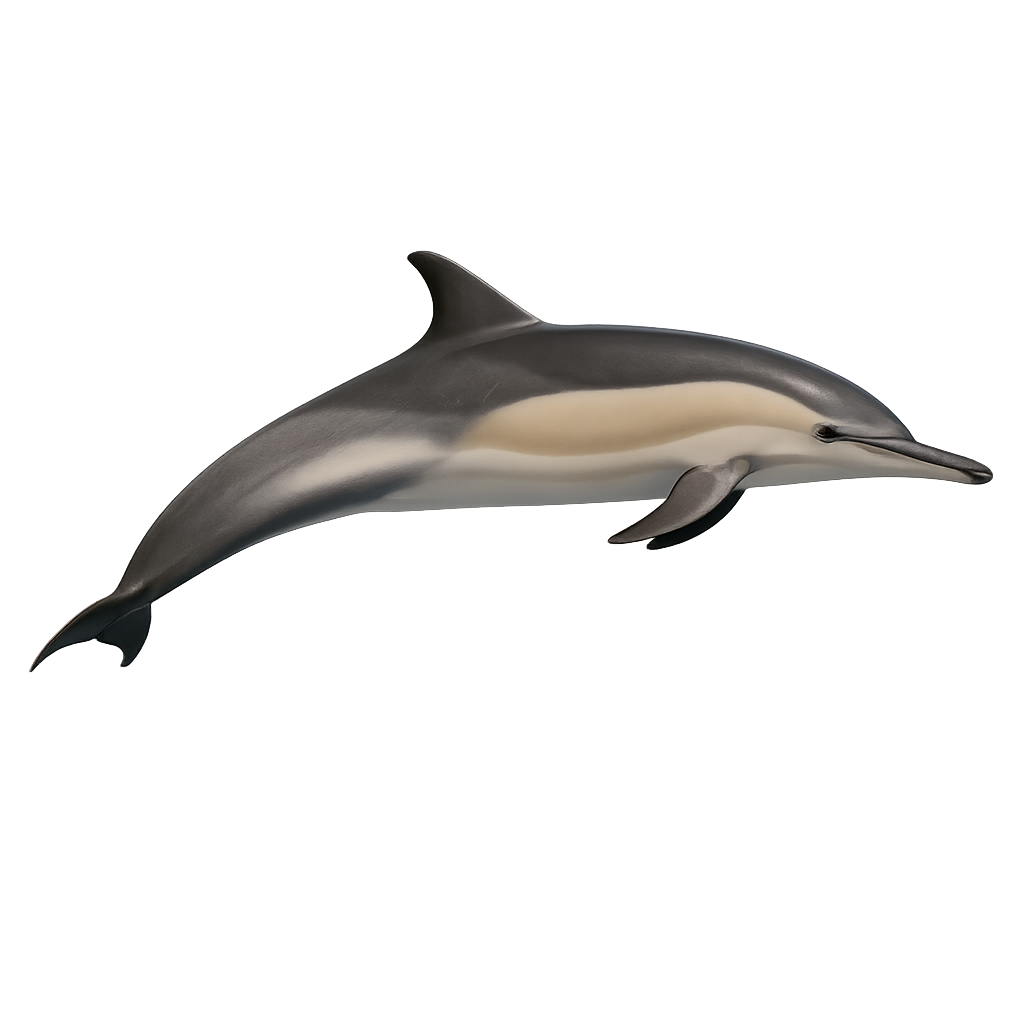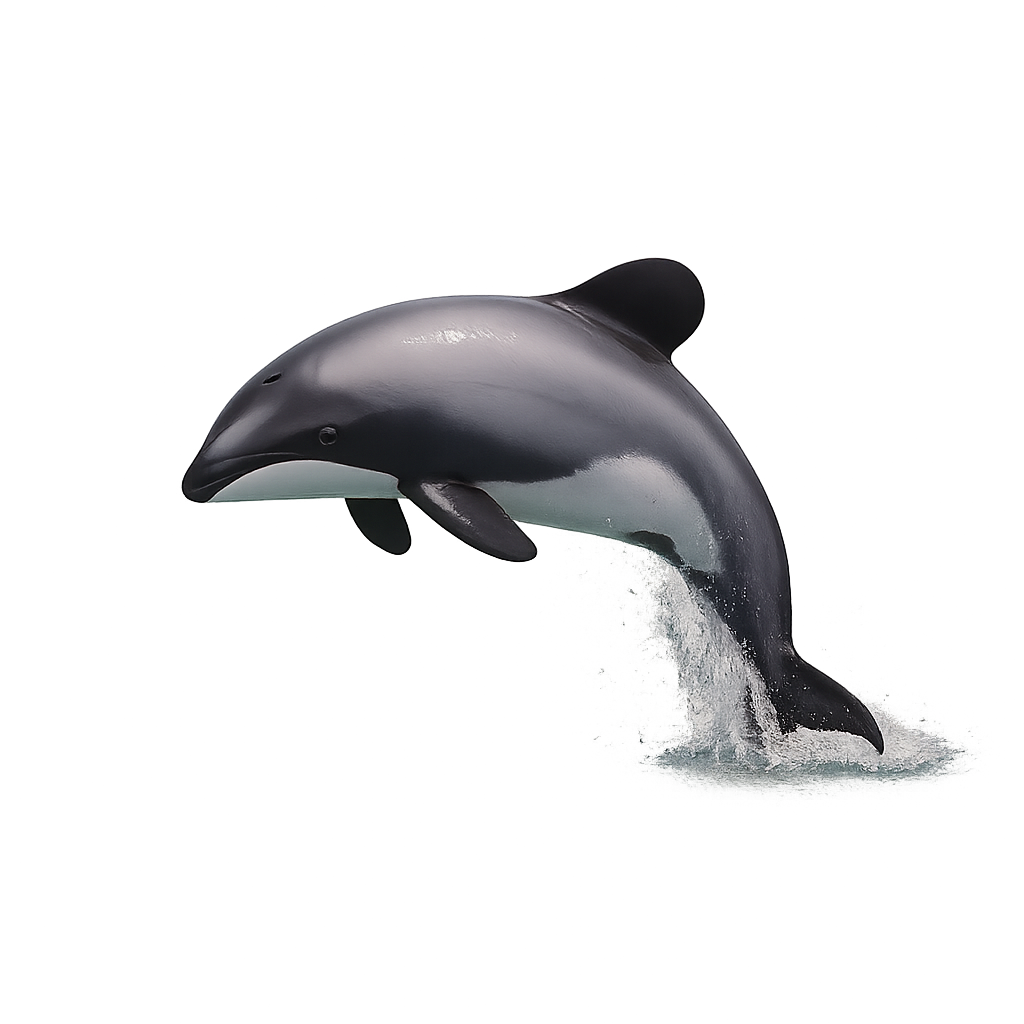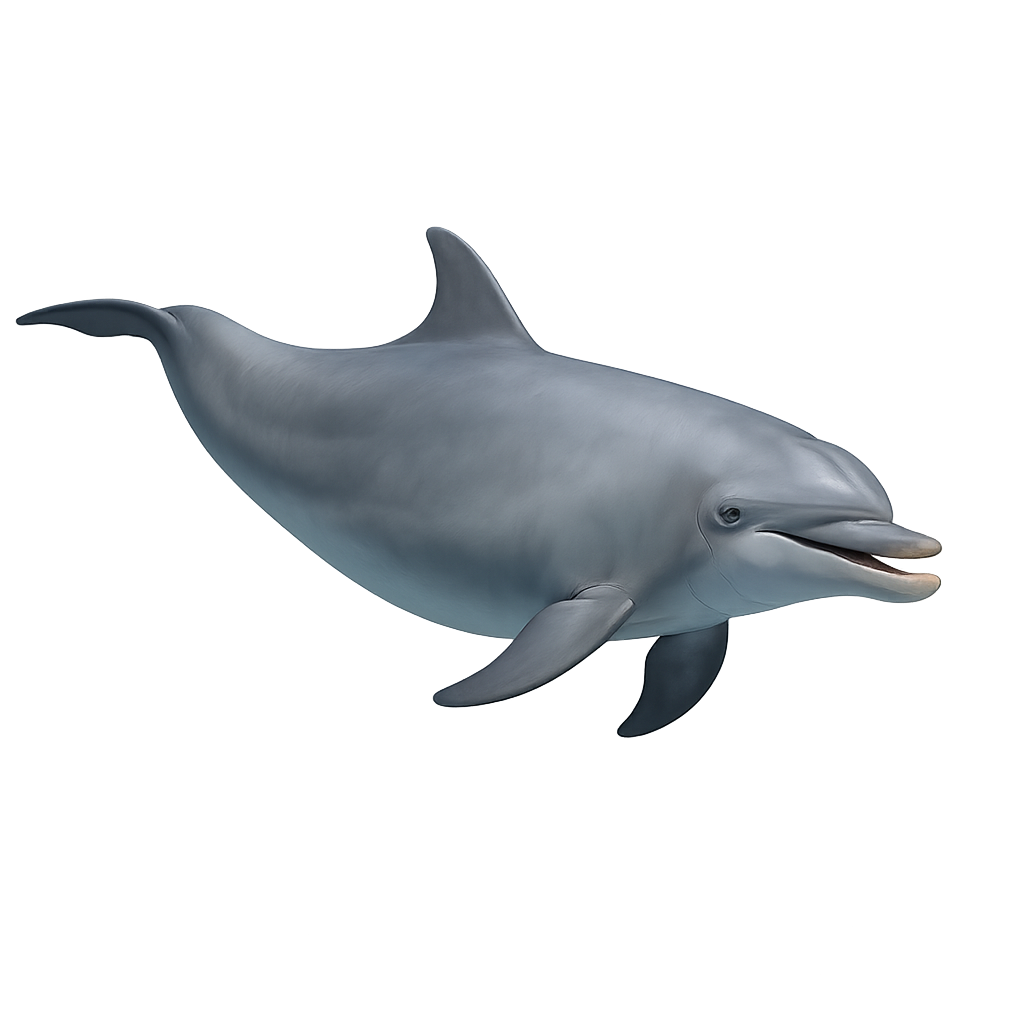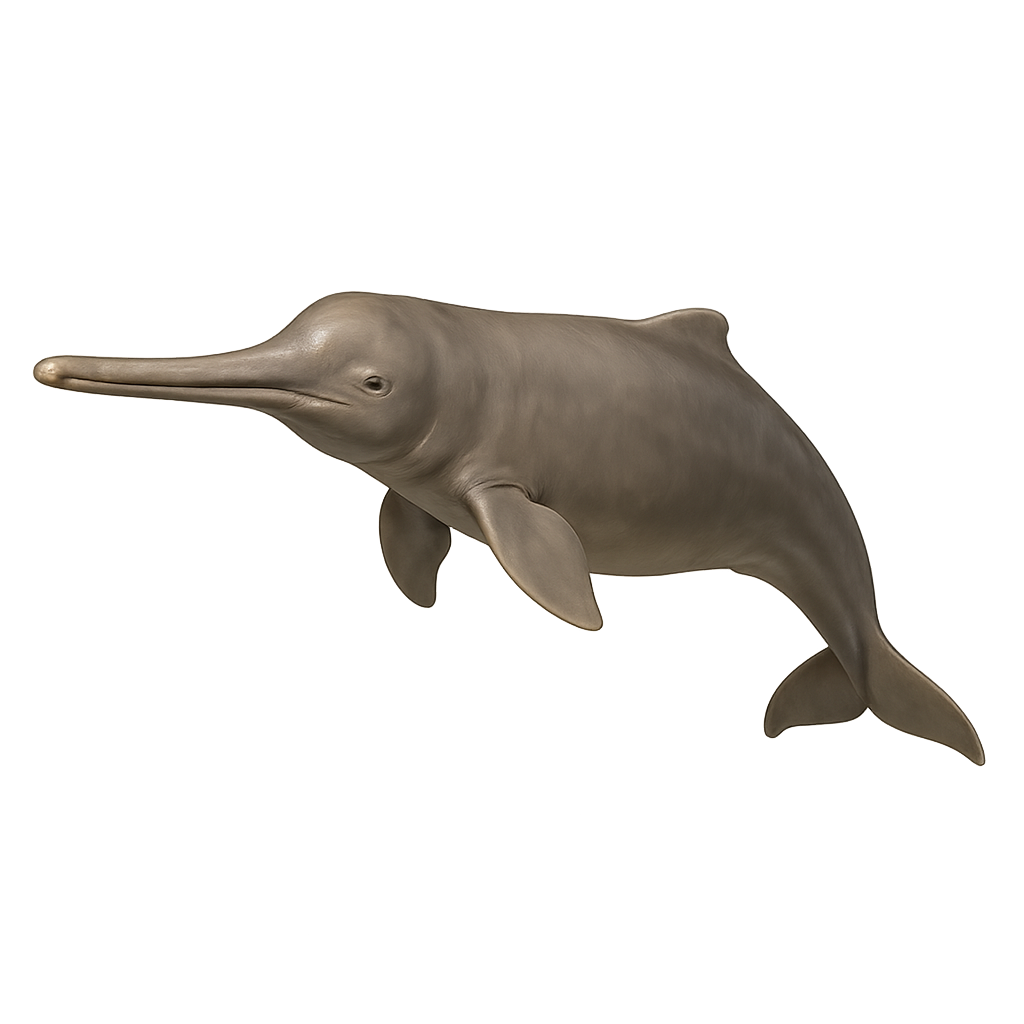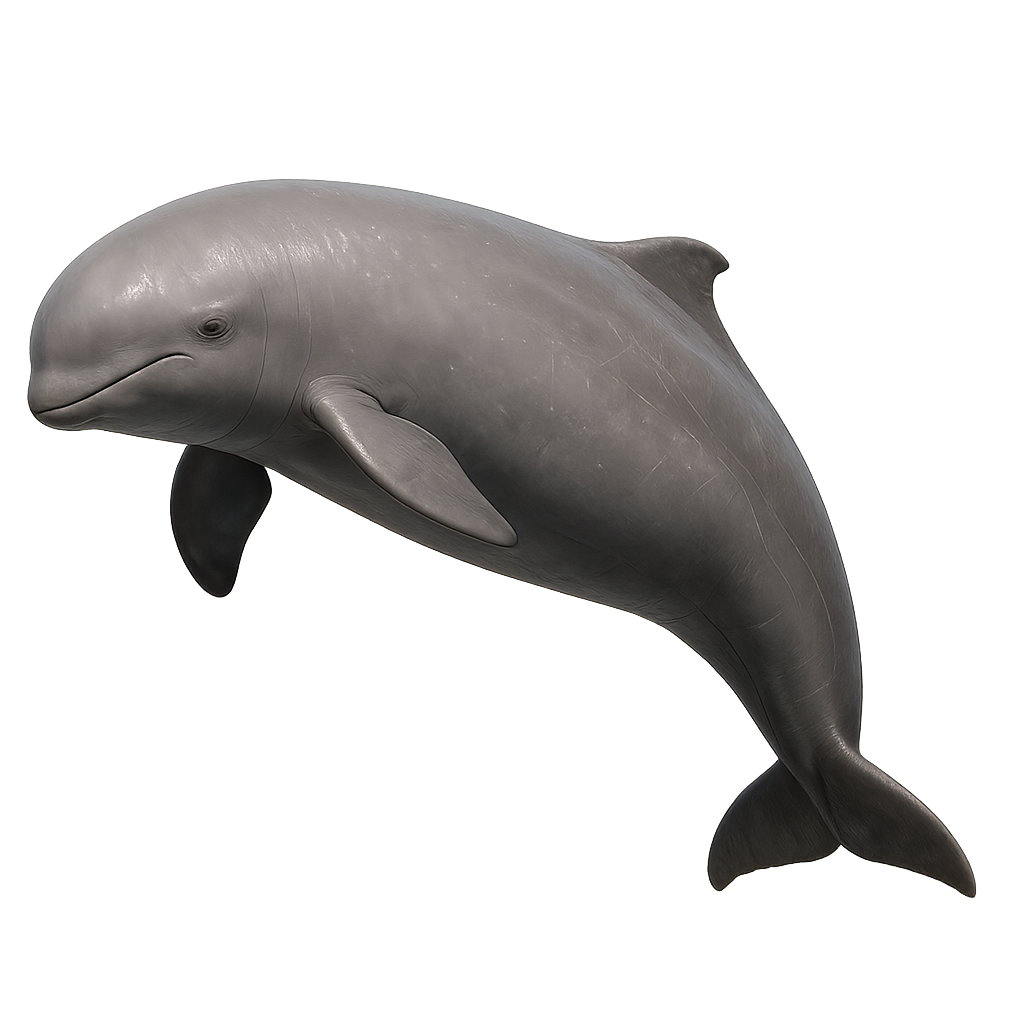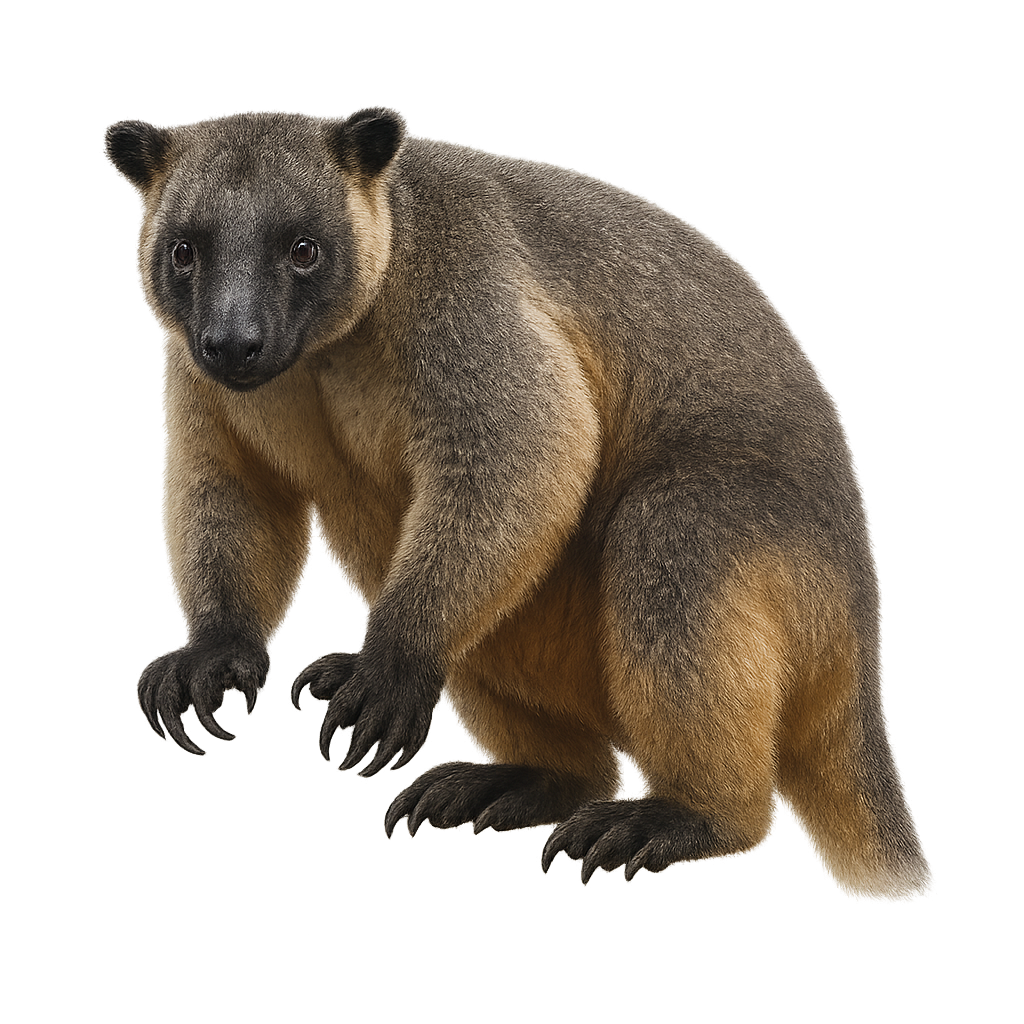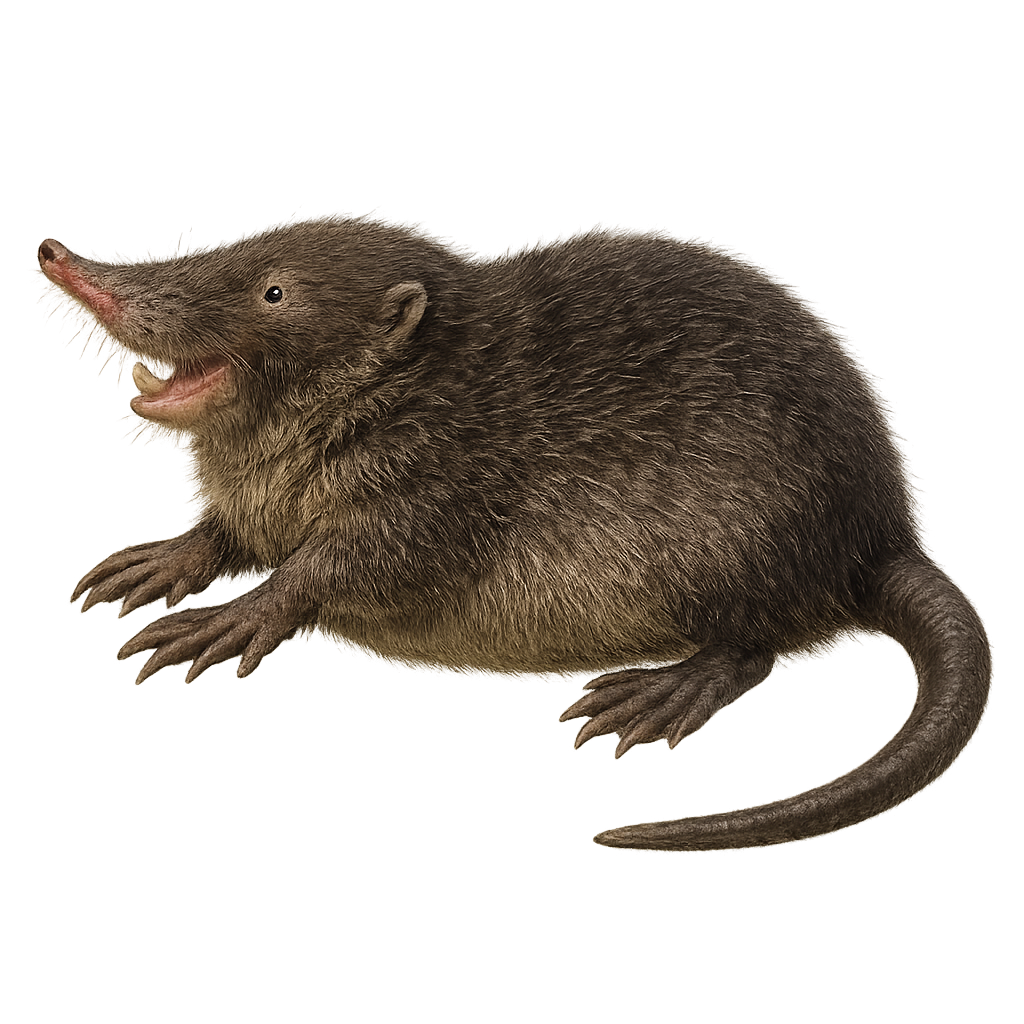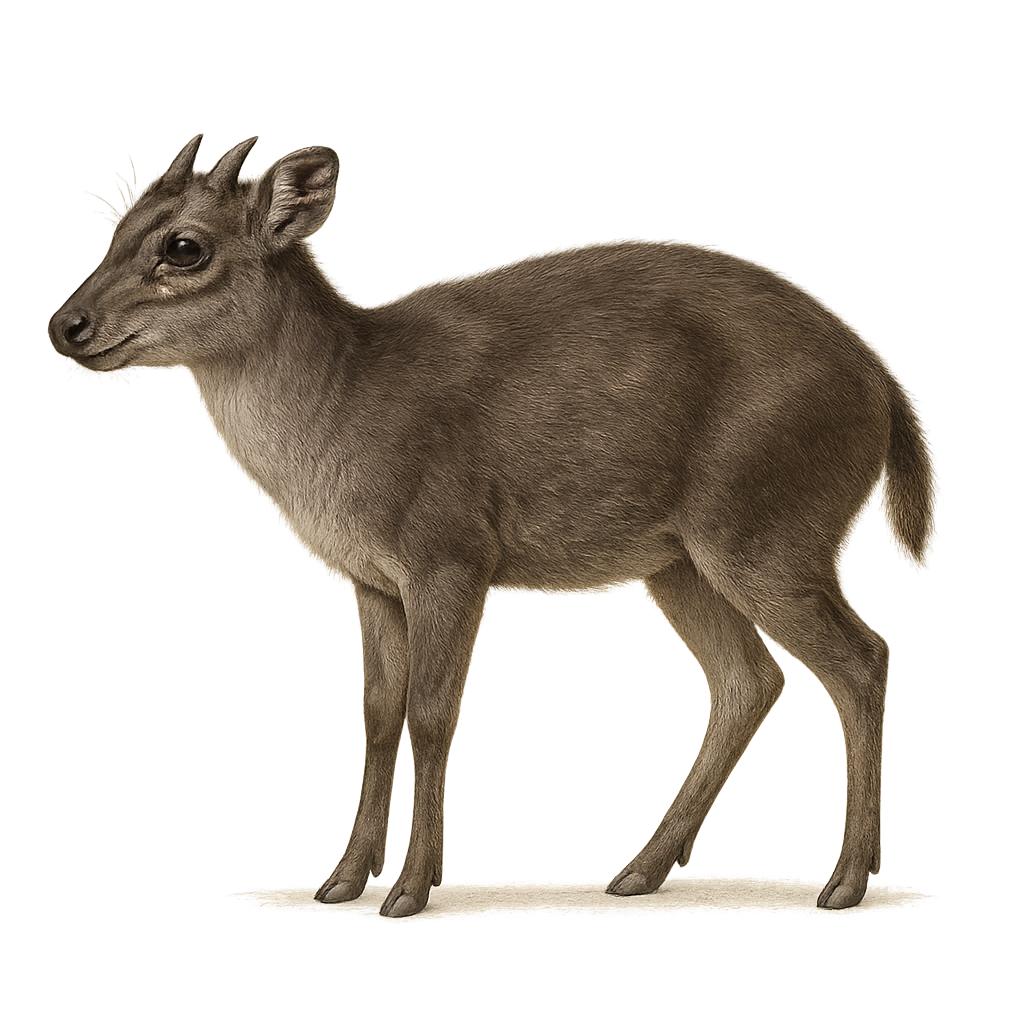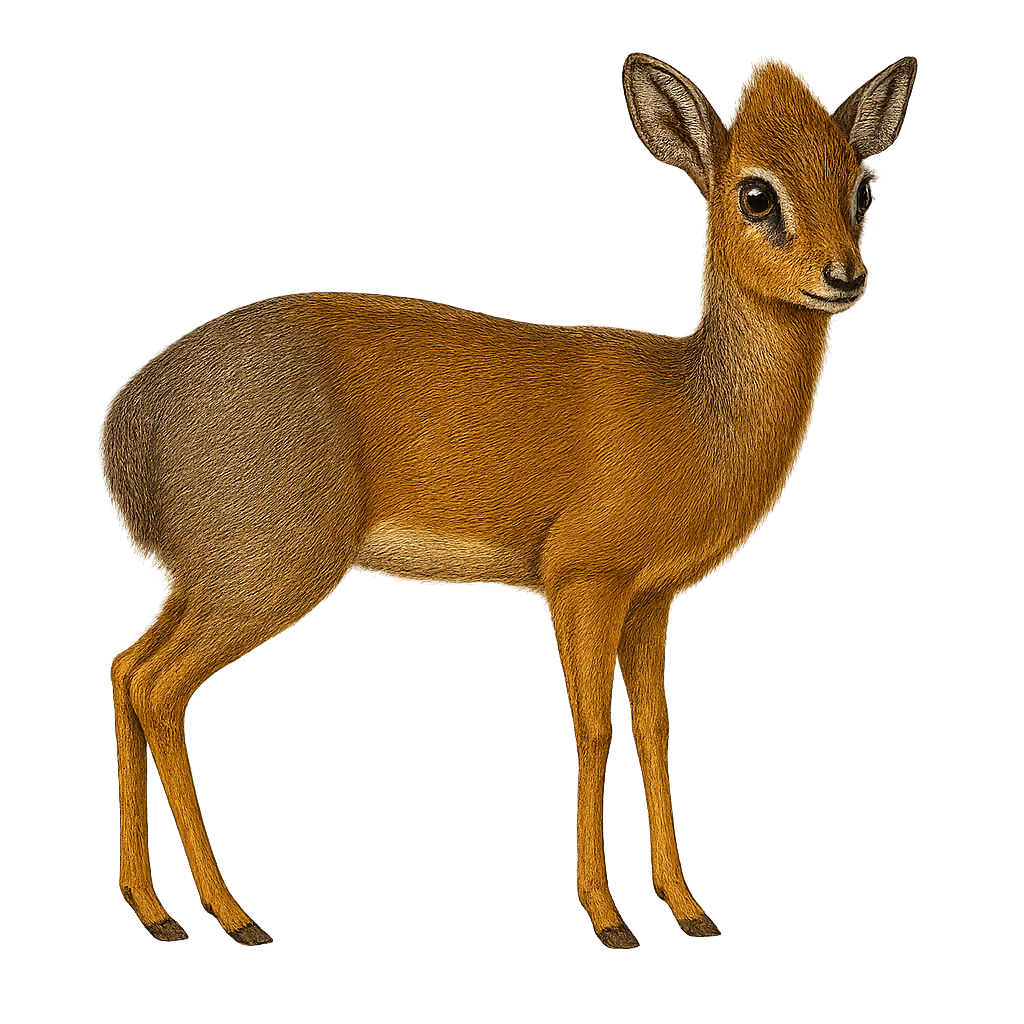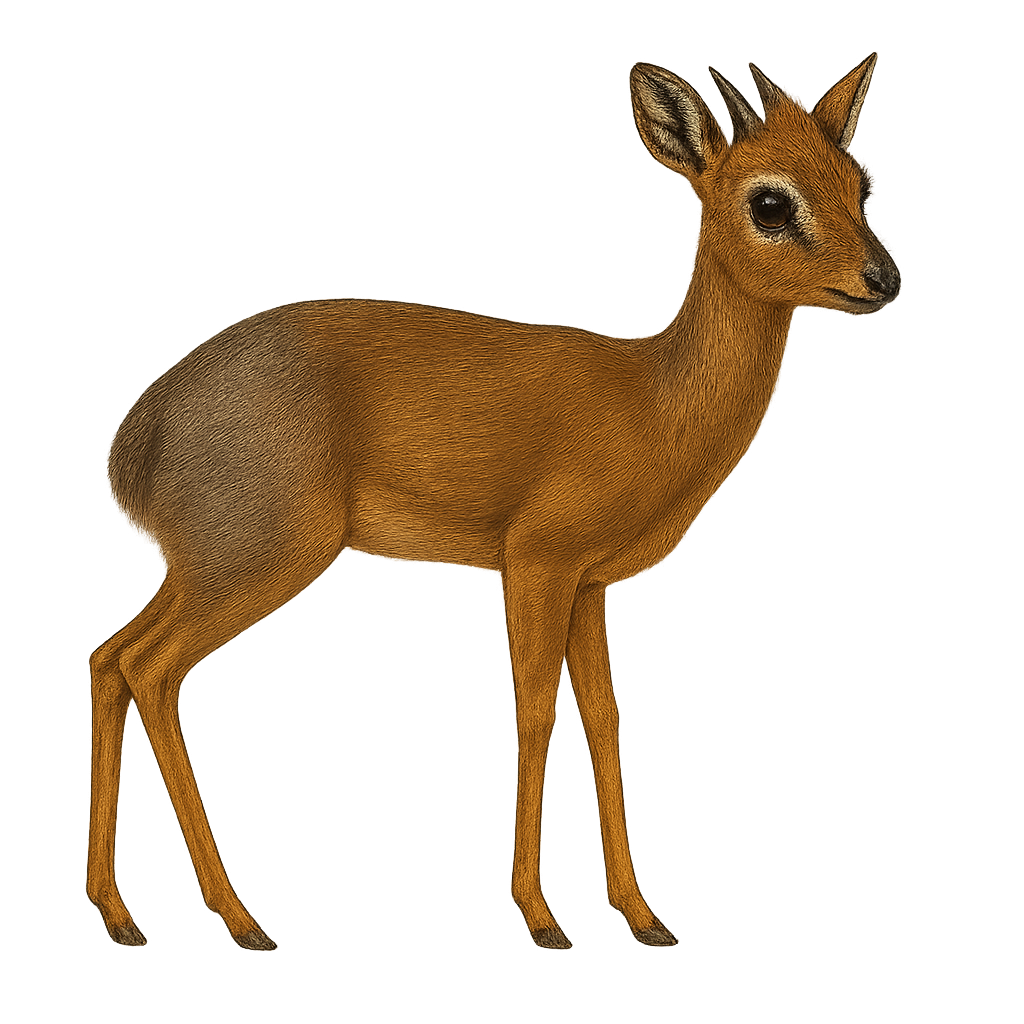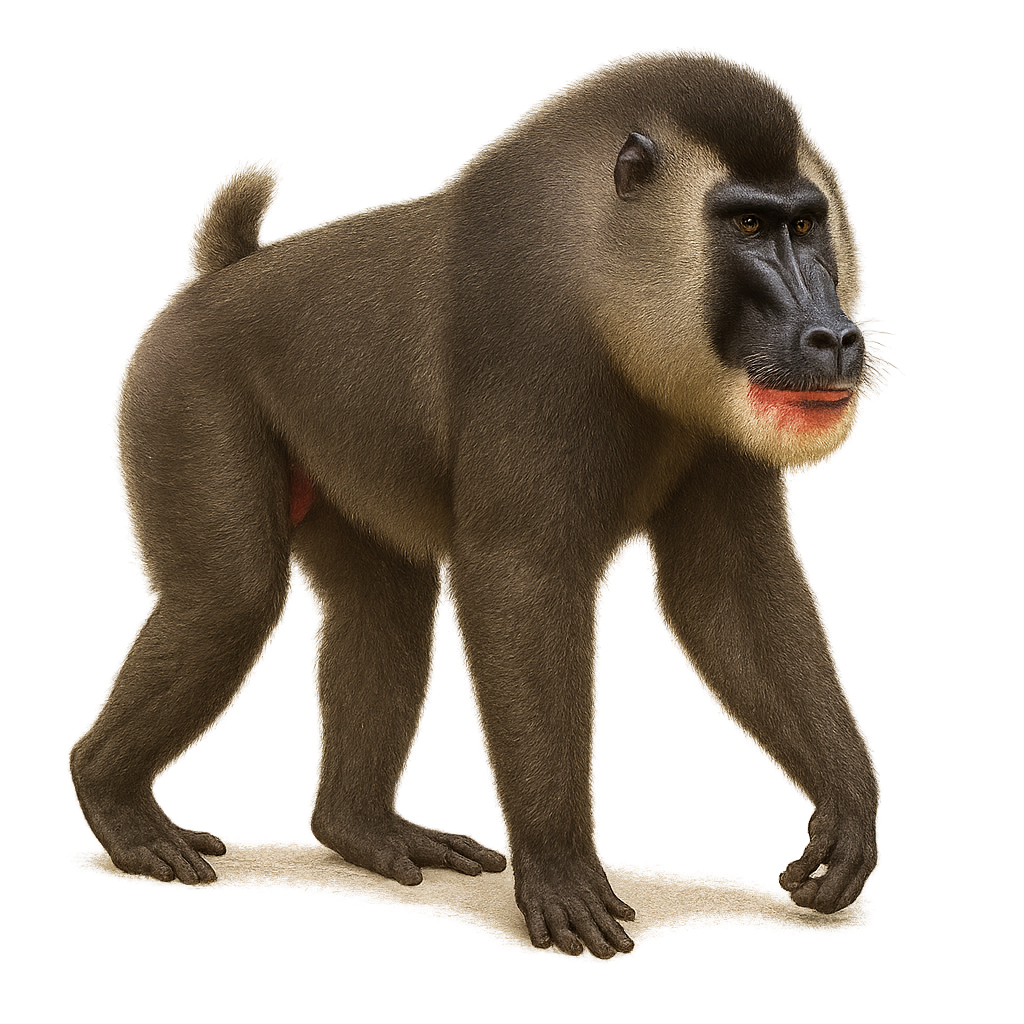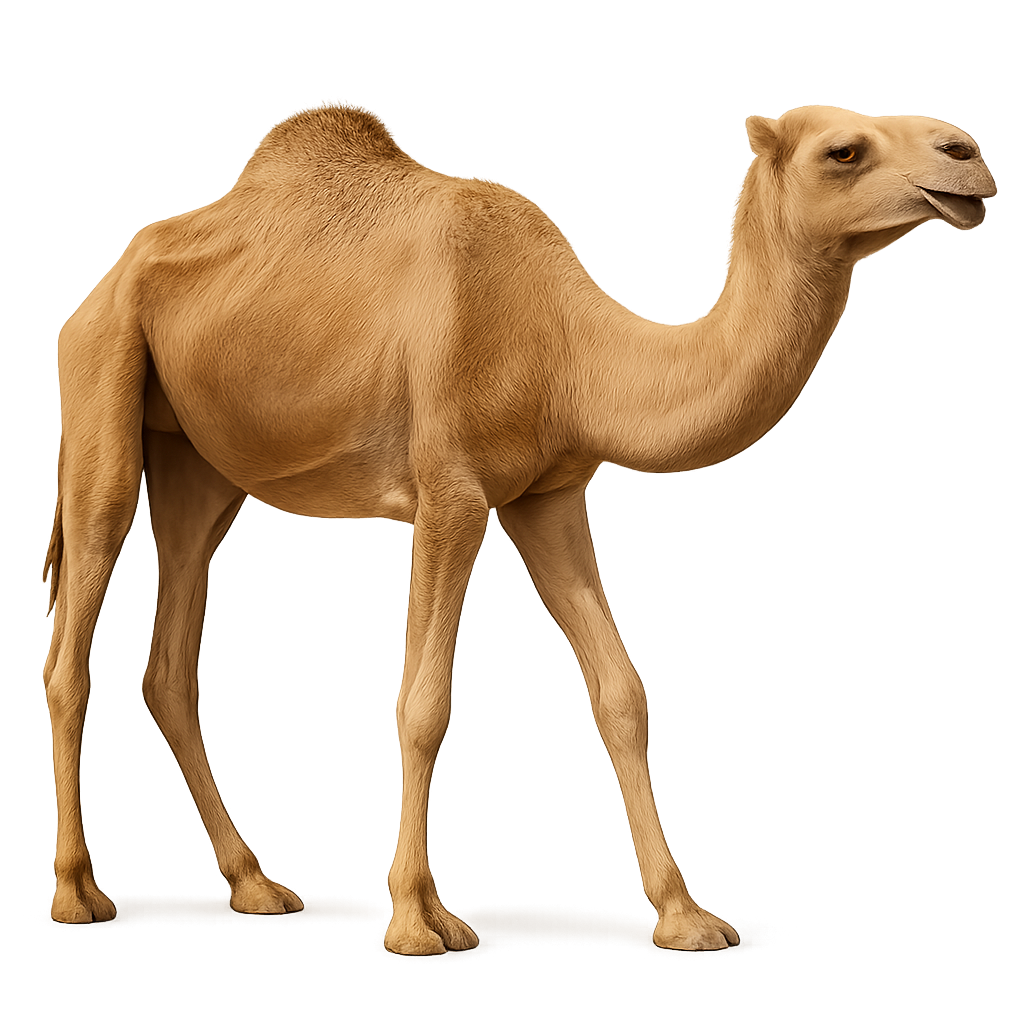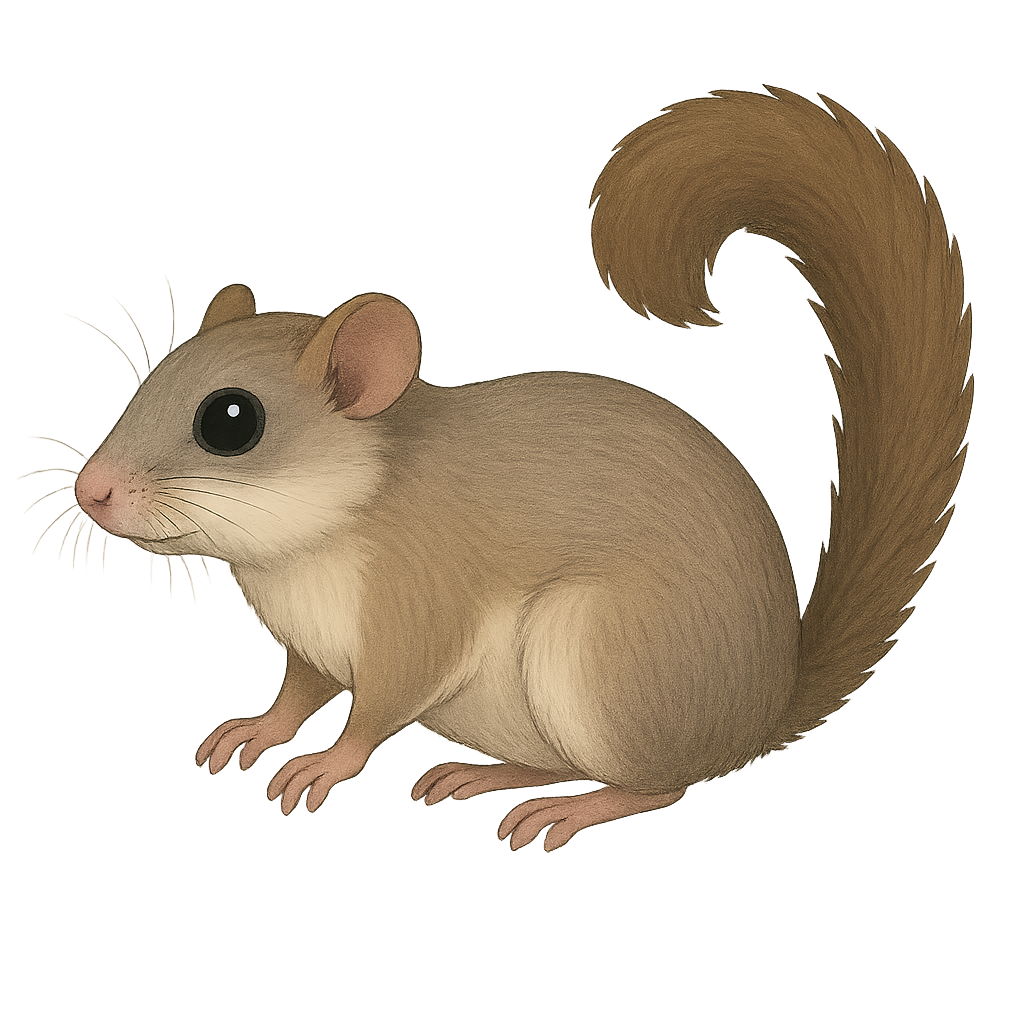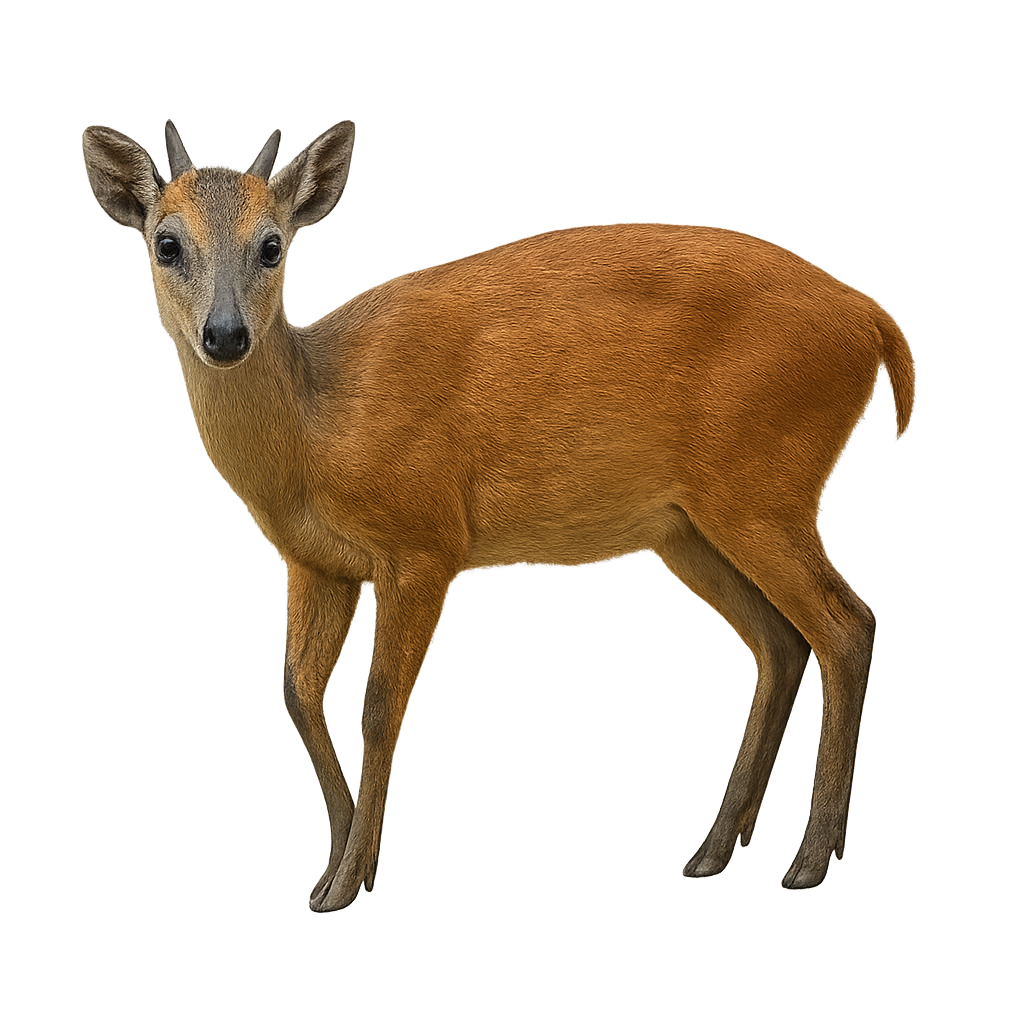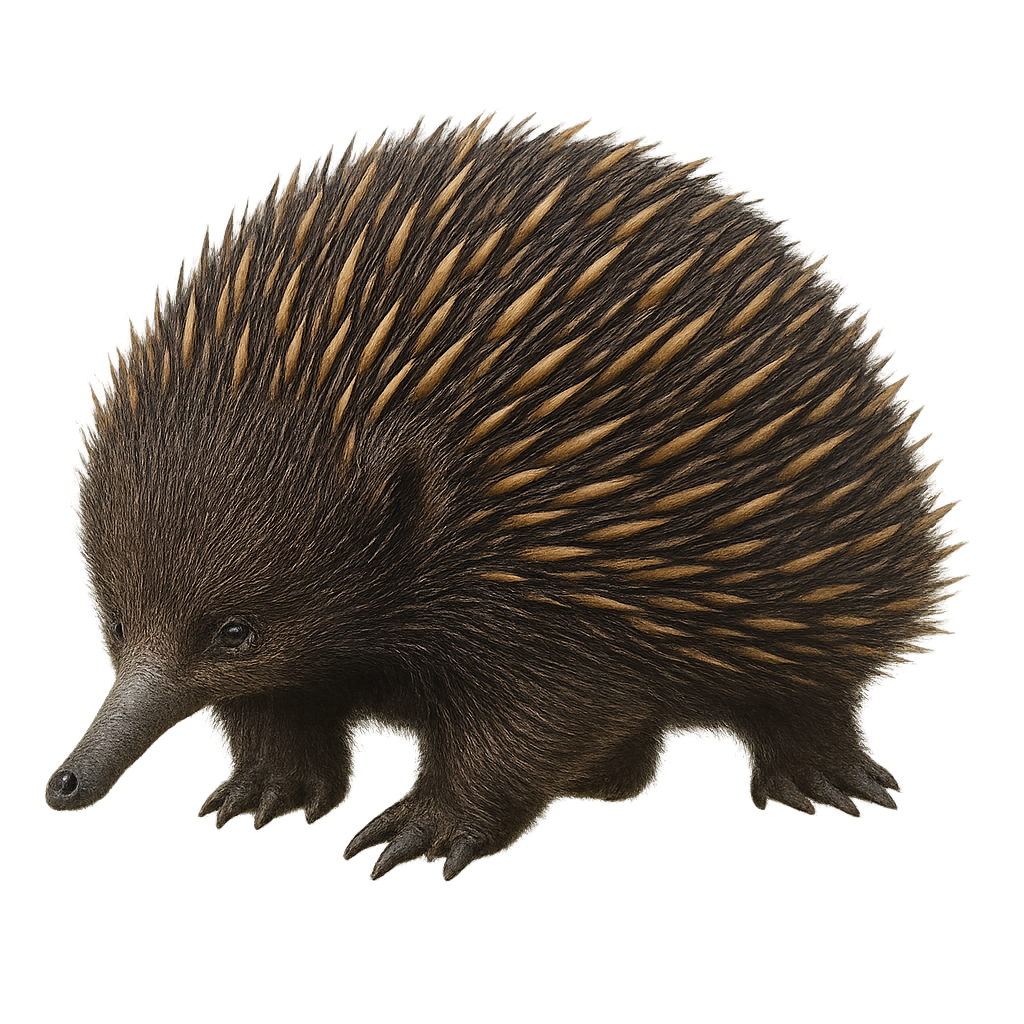The Thomas's kob is a subspecies of the kob antelope, primarily inhabiting the wet savannas and grasslands of West Africa. It is recognizable by its golden-brown coat, lyre-shaped horns, and medium size, reaching about 90 cm at the shoulder. Males are generally larger and more robust than females. They live in complex social groups, often consisting of harems led by a dominant male. The Thomas's kob is a herbivore, feeding mainly on grasses and aquatic plants. It is well adapted to its environment, capable of moving quickly to escape predators. Its population is stable, but it is threatened by hunting and habitat loss.
The Western Red Colobus, or Piliocolobus badius, is an arboreal primate found mainly in the forests of West Africa. Recognizable by its reddish fur and black face, it is a social animal living in groups of up to 80 individuals. These monkeys primarily feed on leaves, but also consume fruits and flowers. Their specialized diet makes them vulnerable to deforestation and habitat loss. The Western Red Colobus is also known for its complex vocalizations used for group communication. Unfortunately, this species is threatened by hunting and habitat destruction, leading to a significant population decline in recent decades.
The Angolan colobus, or Colobus angolensis, is an arboreal primate known for its striking black and white fur. This monkey is particularly recognizable by the long white fringes adorning its shoulders and tail. It primarily inhabits the tropical forests of Central and East Africa, spending most of its time in the canopy. The Angolan colobus is a strict herbivore, feeding mainly on leaves, fruits, and flowers. It lives in social groups of up to 15 individuals, led by a dominant male. Although its habitat is threatened by deforestation, it remains relatively widespread in some areas.
The Ursine Colobus, or Colobus vellerosus, is a medium-sized arboreal primate primarily found in West Africa. Its coat is predominantly black with distinctive white tufts around the face and shoulders, giving it an elegant appearance. It lives in social groups composed of several females and one or two dominant males. These monkeys are mainly folivorous, feeding on leaves, fruits, and flowers. They play a crucial role in seed dispersal, contributing to forest health. Although they are agile in trees, they rarely descend to the ground. Their habitat is threatened by deforestation and hunting, leading to a decline in their population.
The Guereza Colobus is a large primate belonging to the family Cercopithecidae, easily recognized by its distinctive black and white fur. It has a white mane around its face, white limbs, and a long, bushy tail that helps it stabilize in the trees. Its black body is contrasted by tufts of white fur along the sides and back, making it one of the most elegant primates of the forest. It primarily lives in the tropical and subtropical forests of East Africa, spending most of its time in the trees.
The Guereza Colobus is primarily herbivorous, feeding on leaves, fruits, seeds, and flowers. With its specialized stomach, it can digest tough, fibrous leaves that other animals cannot consume. It lives in social groups led by a dominant male and is generally very calm, moving gracefully and agilely through the forest canopy. Although its population remains stable in some protected areas, it faces threats due to deforestation and hunting, causing some populations to be classified as vulnerable.
The Colugo, also known as the flying lemur, is a small tree-dwelling mammal native to Southeast Asia. While not a true lemur, it is often called so due to its gliding abilities, which it performs using a thin membrane of skin that connects its limbs to its body. This gliding allows it to move efficiently from tree to tree in search of food, primarily consisting of leaves, fruits, and flowers. The Colugo is a nocturnal and rather discreet animal, using its dense fur and camouflage to blend into the forest environment.
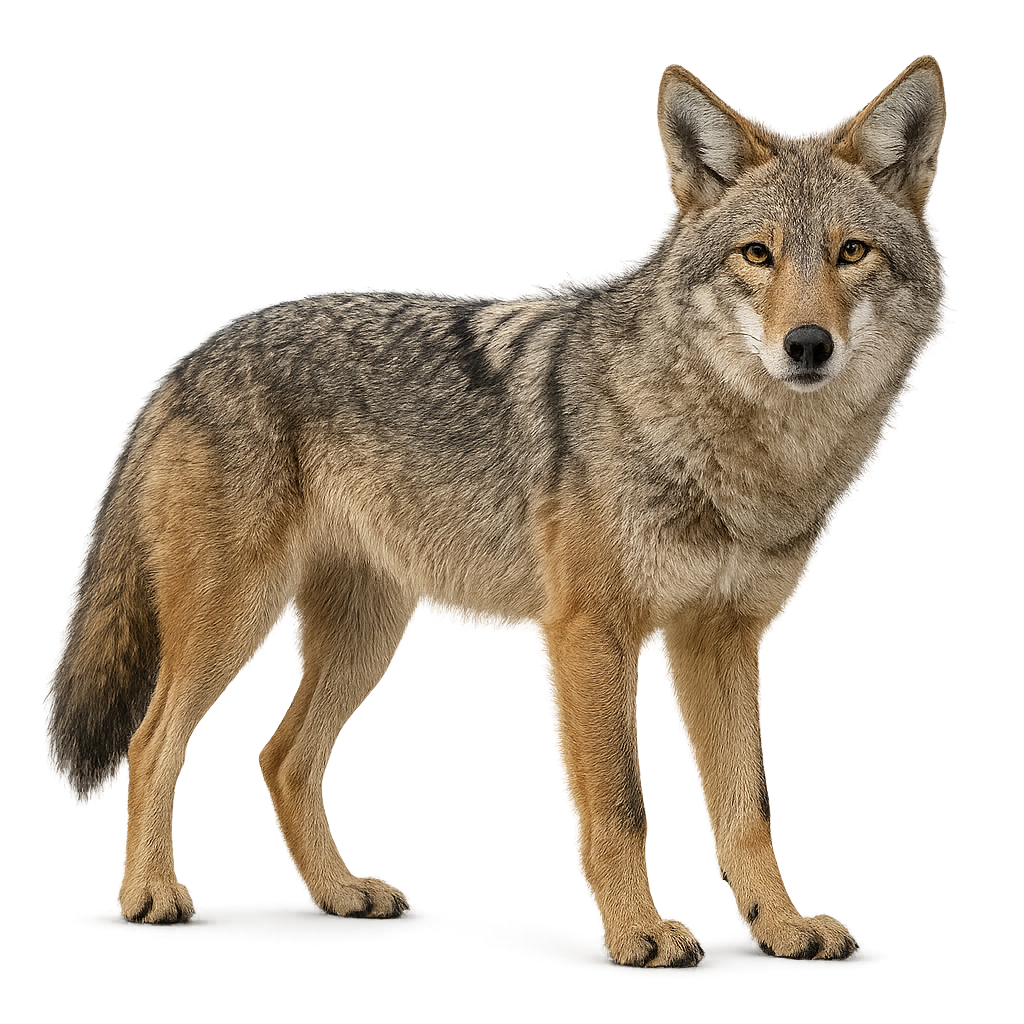
The Coyote is a medium-sized canine, very similar to the wolf but smaller and more agile. Its fur varies from gray to light brown, with a face often marked by black traits, a white chest and belly, and dark legs. The Coyote is easily recognizable by its pointed muzzle, relatively large ears, and bushy tail. It typically stands between 60 and 80 cm at the shoulder, with a total length of 75 to 90 cm for the body, excluding the tail.
This canine is an opportunistic feeder, primarily hunting small mammals such as rodents, rabbits, and sometimes birds, but it can also eat fruits and carrion. Highly adaptable, the Coyote inhabits a wide variety of environments, ranging from prairies and deserts to urban areas, and it is particularly active at dusk and during the night. Unlike other predators, the Coyote often hunts alone or in small groups. Although its population is stable across much of its range, it is sometimes seen as a nuisance in certain areas and faces threats from hunting and habitat loss.

The Fallow Deer, also known by the scientific name Dama dama, is a medium-sized cervid native to Europe and Asia Minor. It stands between 90 and 120 cm tall at the withers and can weigh between 30 and 100 kg, depending on sex and environment. Its coat, usually brown or gray, is spotted with white during the summer season, helping it blend into its forest habitat. The Fallow Deer primarily inhabits forests and woodlands, where it feeds on a variety of vegetation, including grasses, leaves, fruits, and bark. It is also known for its habit of moving in herds, often forming separate groups of males or females. The Fallow Deer is a ruminant herbivore that is primarily active at dawn and dusk. Although it is mostly sedentary, it can travel long distances in search of food or new habitats. During the breeding season, males fight for females, producing characteristic sounds such as roars. This species is listed as of least concern, but it can be threatened by habitat loss and excessive hunting.
The White-fronted Damalisque is a medium-sized antelope, recognizable by its reddish-brown coat and the distinctive white band that crosses its forehead, which gives it its name. It stands between 1.30 and 1.50 meters tall at the withers and weighs between 50 and 70 kg. This mammal primarily inhabits open savannas, grasslands, and semi-desert areas, preferring open terrain where it can graze on grasses, leaves, and stems. It is well adapted to heat and drought, thanks to its short coat and behavior of seeking shade during the hottest parts of the day. The White-fronted Damalisque lives in small groups, often consisting of females and young, while adult males usually live alone or in small groups. It is mainly active in the morning and late afternoon, when it is easier to feed while avoiding the heat of the day. While the species is currently in good health, it faces threats such as illegal hunting, habitat loss due to human expansion, and competition with livestock for food resources.
The Common Damalisque is a medium-sized antelope, recognizable by its reddish-brown or gray-brown coat, with distinctive white markings on the legs and belly. It stands about 1.10 to 1.30 meters tall at the withers and weighs between 45 and 70 kg. This mammal primarily inhabits the savannas and open grasslands of East Africa, notably in Kenya, Tanzania, and Uganda. It mainly feeds on grasses and herbaceous plants but can also consume leaves and fruits when grass resources are limited. The Common Damalisque is known for its social behaviors, typically living in groups of females and young, while adult males are often solitary or form small groups. During the breeding season, males fight to defend their territory and access females. While it is currently listed as of least concern, the Common Damalisque faces threats such as habitat loss due to agriculture and urban expansion, as well as hunting for its meat and skin.
The rock hyrax, or Procavia capensis, is a small herbivorous mammal found in Africa and the Middle East. It resembles a large rodent but is more closely related to elephants. Measuring about 50 cm in length and weighing 4 to 5 kg, it has dense brown fur, rounded ears, and short legs. Rock hyraxes live in colonies and are often seen basking on rocks. They communicate through a variety of calls and have a complex social structure. Although primarily herbivorous, they may also consume insects. Their adaptation to rocky environments allows them to evade many predators.
The White-beaked Dolphin is a small cetacean from the Delphinidae family, easily recognizable by its white beak and distinctive markings on its body. It typically measures between 1.5 and 2.5 meters in length and weighs between 70 and 150 kg. This dolphin primarily inhabits the cold and temperate waters of the North Atlantic, particularly around Iceland, Greenland, and the North American coasts. It primarily feeds on fish and cephalopods, using group hunting techniques to capture its prey. The White-beaked Dolphin is often seen in small groups or families, and it is known for its complex social behaviors, including group play and acrobatic leaps. This dolphin has a lifespan of about 20 to 30 years in the wild. Although the species is not currently endangered, it faces threats from pollution, underwater noise, and ship collisions. Managing its marine habitats is crucial for the preservation of this species.
The Common Dolphin is a medium-sized cetacean, easily recognizable by its streamlined body and distinctive beak. It typically measures between 2 and 2.5 meters in length and weighs between 100 and 150 kg. This dolphin is widely distributed in temperate and tropical waters, particularly in the Mediterranean, the Atlantic, and the seas around Asia. The Common Dolphin primarily feeds on fish, cephalopods, and sometimes small crustaceans, hunting in highly coordinated groups. Its social structure is complex, with groups ranging from a few individuals to several hundred, depending on environmental conditions and the availability of food resources. It is also known for its acrobatic behaviors, such as jumping and group play, and is often seen following boats. While this species is not currently endangered, it faces threats from pollution, disturbances caused by human activities at sea, and bycatch in fishing nets.
Hector's dolphin is one of the smallest dolphin species in the world, with an average size of 1.2 to 1.5 meters. It primarily inhabits shallow coastal waters of New Zealand, where it feeds on fish and squid. This dolphin is recognizable by its small, compact body, rounded fins, and distinctive face. Threatened by pollution, bycatch, and habitat loss, it is classified as endangered.
The Indo-Pacific bottlenose dolphin measures 2–3 m and weighs 150–230 kg, with a light grey streamlined body and a short beak. It forms small coastal groups in shallow tropical and subtropical waters, feeding on fish, cephalopods and crustaceans. Highly social and playful, it often interacts with boats, performing spectacular leaps and bow-riding.
The South Asian river dolphin is a small freshwater cetacean in the family Platanistidae, measuring 2–2.5 m in length, with a pale grey streamlined body and a long narrow beak. It inhabits shallow rivers, oxbow lakes, and canals of the South Asian subcontinent, feeding mainly on freshwater fish and crustaceans. Blind, it uses echolocation to navigate and hunt in turbid waters.
The Irrawaddy dolphin, Orcaella brevirostris, is a freshwater and coastal cetacean known for its rounded forehead and lack of a distinct beak. It typically measures between 2 and 2.7 meters and weighs up to 150 kg. Its skin is light gray with a paler belly. This dolphin is often seen in small groups and is noted for its social and curious behavior. It can swim in both freshwater and saltwater, frequenting estuaries, rivers, and coasts. Unfortunately, it is threatened by habitat degradation, accidental capture in fishing nets, and pollution. Its conservation is crucial to maintaining the balance of the aquatic ecosystems it inhabits.
The Lumholtz's Tree Kangaroo is an arboreal marsupial native to the rainforests of northeastern Australia. It is known for its ability to climb and leap between trees, aided by its strong limbs and long tail, which acts as a counterbalance. Its fur is typically dark brown on the back and lighter on the belly, providing camouflage in its habitat. It primarily feeds on leaves, fruits, and flowers. Although mostly nocturnal, it can occasionally be seen during the day. Its population is stable but vulnerable to deforestation and climate change.
The Russian Desman, or Desmana moschata, is a small semi-aquatic mammal belonging to the Talpidae family. It is primarily found in the wet regions of Russia and Ukraine. This peculiar animal has a long, flexible snout and a flattened tail, which allow it to move easily in water. Its dense, waterproof fur protects it from the cold, while its webbed feet facilitate swimming. The Russian Desman is a nocturnal animal, feeding mainly on aquatic insects, small fish, and crustaceans. Unfortunately, it is threatened by habitat destruction and water pollution, leading to a significant decline in its population.
The Tasmanian Devil is a medium-sized carnivorous marsupial, easily recognized by its black fur and white patches on its chest and hips. It measures about 50 cm in length, with a tail of 25 cm, and weighs between 5 and 10 kg. This nocturnal predator is found exclusively on the island of Tasmania, where it primarily feeds on small mammals, birds, insects, and carcasses of dead animals. The Tasmanian Devil is known for its aggressive feeding behavior, often making growling and screaming noises. It is also a solitary animal, only coming together during breeding or when it finds a large carcass. While this species plays an important scavenging role in its ecosystem, it is now threatened by a devastating infectious disease, Devil Facial Tumour Disease (DFTD), which has significantly reduced its population. Habitat loss and vehicle collisions also pose threats to its survival.
The Cephalophus monticola, commonly known as the blue duiker, is a small mammal from the Bovidae family. It is one of the smallest antelopes, standing about 30 to 40 cm tall at the shoulder and weighing between 3 and 6 kg. Its coat is typically reddish-brown with shades of gray, allowing it to blend effectively into its natural habitat. It is primarily nocturnal and crepuscular, feeding on leaves, fruits, and flowers. The blue duiker is solitary or lives in small family groups. It is very shy and uses its agility to escape predators. It is mainly found in dense forests and wooded areas of Central and East Africa.
The Cavendish Dik-dik is a small antelope found mainly in the semi-arid zones and savannas of East Africa. It stands about 40 cm tall at the shoulder, with a body length of 60 to 70 cm, and weighs between 3 and 6 kg. This small herbivore is easily recognized by its compact size, sharp muzzle, and bright eyes. Its coat is typically gray-brown, with lighter shades on the belly and distinct markings around the eyes, giving it an alert expression. The Cavendish Dik-dik is a discreet animal, often seen alone or in small family groups, preferring to avoid large human concentrations. It primarily feeds on herbaceous plants, fruits, seeds, and leaves. Its small size allows it to slip easily through bushes and tall grasses to escape predators. While the species is not currently endangered, it is vulnerable to habitat loss and pressures from human activities.
The Kirk's Dik-dik is a small antelope, recognizable by its modest size and distinctive features, including its elongated snout and large, expressive eyes. Standing about 40 cm tall at the withers and weighing between 3 and 6 kg, it is one of the smallest members of the antelope family. Its coat is usually light brown or gray, with a paler belly and distinct facial markings. The Kirk's Dik-dik primarily inhabits savannas and wooded areas in East Africa, notably in Somalia, Kenya, Tanzania, and Ethiopia. It feeds mainly on leaves, fruits, and herbaceous plants. This small herbivore is mostly active at dusk and during the night, using its well-developed sense of smell to detect predators, emitting a characteristic call to alert other members of its group. The Kirk's Dik-dik is typically solitary or lives in small family groups. Although it is not currently threatened, it faces dangers such as habitat loss due to agricultural expansion and hunting.
Drill
Mandrillus leucophaeus
The Mandrillus leucophaeus, commonly known as the drill, is a primate from the Cercopithecidae family. It is characterized by its dark fur and colorful face, with shades of blue and pink around the nose. Males are significantly larger than females, weighing up to 30 kg. They primarily inhabit the tropical forests of Cameroon, Nigeria, and Equatorial Guinea. Drills are social animals, living in groups led by a dominant male. Their diet mainly consists of fruits, leaves, and insects. Unfortunately, this species is threatened by deforestation and hunting, leading to a significant decline in its population.
The dromedary, Camelus dromedarius, is a large mammal with a single hump, well adapted to arid and desert environments. Originally from the Arabian Peninsula, it is now widely domesticated and used as a pack and transport animal in many regions of the Middle East and North Africa. Its hump, made of fat, allows it to survive long periods without water. The dromedary has a distinctive gait, moving at a steady pace over long distances. Its thick skin and closable nostrils protect it from sandstorms. Dromedaries are herbivores that primarily feed on dry and thorny vegetation.
The Dormouse with a Bushy Tail is a small nocturnal rodent, easily recognizable by its large bushy tail, which is one of its distinctive features. It measures about 20 to 25 cm in length, with a tail of around 10 to 15 cm, and weighs between 50 and 150 g. Its coat is generally gray or brown, with a lighter shade on the belly, and it has large round ears and bright eyes. The Dormouse with a Bushy Tail primarily lives in forests, hedgerows, and gardens, where it feeds on fruits, seeds, nuts, as well as small creatures like insects. It is mainly active at night, taking refuge in tree holes or burrows during the day. This rodent hibernates during the winter, entering a state of torpor for several months, which allows it to survive the cold temperatures. While the species is not currently endangered, it faces threats from deforestation and the reduction of its natural habitat.
The common duiker, or Sylvicapra grimmia, is a small African antelope found in various regions across the continent. It is characterized by its modest size, reaching about 50 cm at the shoulder, and its grayish-brown coat that allows it to blend into its surroundings. Males have small, straight horns, while females are hornless. This animal is primarily solitary, although it can sometimes be seen in small family groups. It is highly adaptable, living in diverse habitats ranging from savannas to sparse forests. The duiker is an opportunistic herbivore, feeding on leaves, fruits, and sometimes bark. Its ability to survive in varied environments makes it a resilient species.
The Cephalophus natalensis, or Natal Red Duiker, is a small African antelope that primarily inhabits dense forests and wooded areas in eastern South Africa. It is distinguished by its reddish coat, slender legs, and short, straight horns. This discreet mammal stands about 40 to 50 cm at the shoulder and weighs between 12 and 14 kg. It is mainly active at dawn and dusk, feeding on leaves, fruits, and flowers. The Natal Red Duiker is known for its shy nature and ability to blend into its environment to escape predators. Its population is stable, although deforestation poses a potential threat.
The Dugong is a marine mammal and herbivore primarily found in warm, shallow coastal waters of the Indian Ocean and Pacific. Closely related to manatees, it is more agile, with a streamlined body designed for swimming. The Dugong feeds on seagrasses, primarily seagrass species, which it pulls from the ocean floor. Although a protected species, the Dugong is threatened by habitat loss, pollution, accidental fishing, and climate change.
The short-beaked echidna is a small monotreme mammal, 30–45 cm long, covered in spines with an elongated head bearing a long tubular snout. Endemic to Australia and New Guinea, it inhabits forests, scrublands and open areas, feeding mainly on ants and termites with its fast, sticky tongue. Solitary, it alternates nocturnal and crepuscular activity phases to avoid heat.


